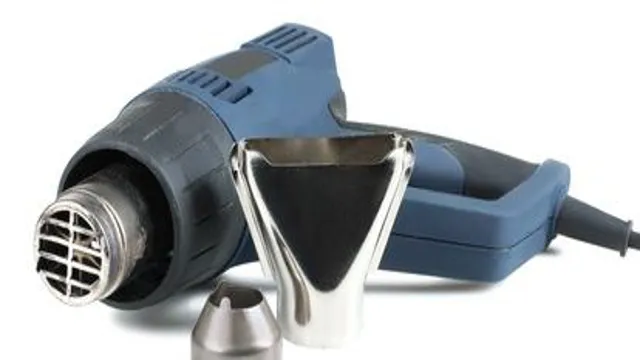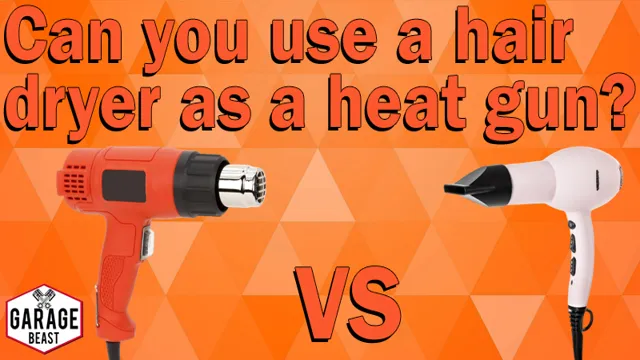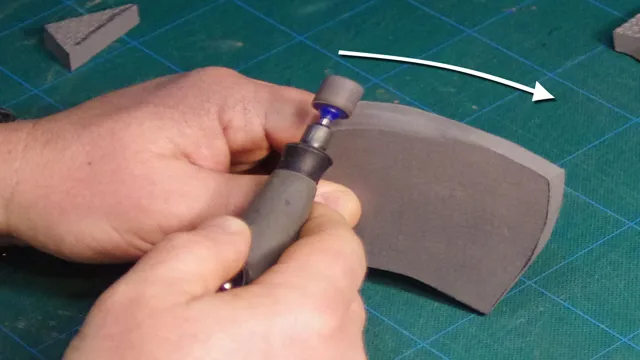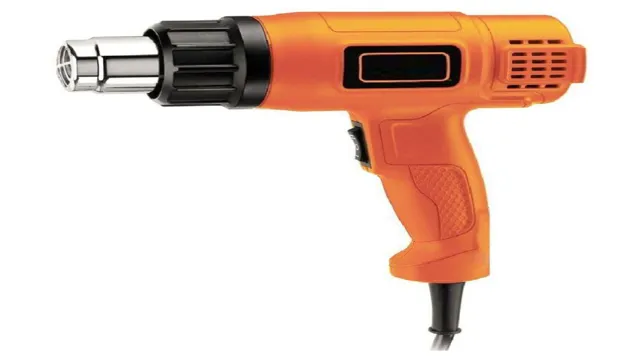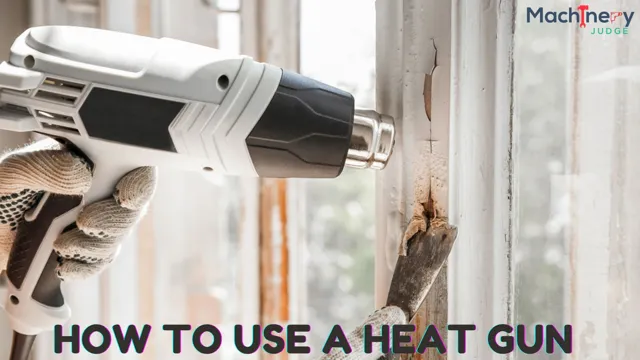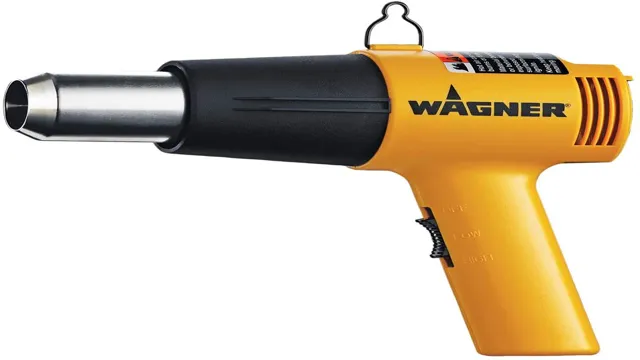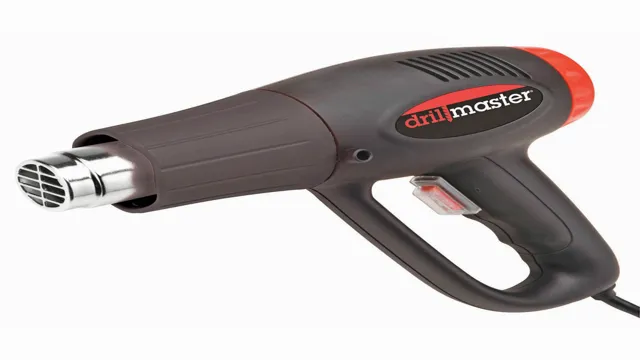Will a Heat Gun Remove Paint from Surfaces Effortlessly? Here’s Everything You Need to Know!

Are you tired of spending hours scraping away at old, stubborn paint? Have you considered using a heat gun to make the process quicker and easier? Heat guns have long been a popular choice for home DIY projects, and for good reason: they have a wide range of applications, including paint removal. But can a heat gun really remove paint effectively? The simple answer is yes, but like most things in life, there are some important considerations to keep in mind. In this article, we’ll take a closer look at how heat guns work, the benefits of using them for paint removal, and how to use them safely and effectively.
Understanding Paint Removal Process
If you’re wondering whether a heat gun would remove paint, the answer is yes. A heat gun is a handy tool that can effectively strip paint from a variety of surfaces such as wood, metal, and brick. However, it’s important to remember that different types of paint require different levels of heat to remove them, so it’s essential to consider the type of paint you’re dealing with when using a heat gun.
Additionally, safety precautions should always be taken when using a heat gun, including wearing protective gear and ensuring adequate ventilation. While using a heat gun may seem like an efficient and quick way to remove paint, it can be time-consuming and labor-intensive, particularly when dealing with larger surface areas. Nonetheless, for smaller projects, a heat gun can be an effective and relatively inexpensive option for paint removal.
Types of Paint to Remove with Heat Gun
When it comes to removing paint, various methods can be used depending on the type of paint and the surface it’s on. Heat guns are great for removing paint as they soften it up, making it easier to scrape off. However, not all types of paint are safe to remove using a heat gun.
For instance, lead-based paints release toxic fumes when heated, which can be very hazardous to your health. Therefore, it’s important to know the different types of paint that can be safely removed using a heat gun. These include oil-based paint, varnish, and latex paint.
While oil-based paints and varnish are high-temperature resistant, they still soften up when heated. Latex paint, on the other hand, is water-based, making it easier to remove with a heat gun. By understanding the types of paint that can be removed using a heat gun, you can easily tackle any paint removal job without damaging the surface or putting your health at risk.

How Heat Gun Works in Removing Paint
When it comes to removing paint, a heat gun can be an incredibly effective tool. But how does it work? Essentially, a heat gun uses hot air to soften paint, making it easier to scrape off or melt away. This is particularly useful when working with older or stubborn paint, as it can be difficult to remove with other methods.
By applying heat directly to the surface, the paint is loosened and can be removed more easily, without damaging the underlying material. Of course, it’s important to be careful when using a heat gun, as they can get extremely hot and potentially cause burns or damage. Always follow safety guidelines and use caution when working with heat guns.
Overall, a heat gun can be a powerful tool in your paint removal arsenal, making the process faster, easier, and more efficient.
Safety Precautions While Using Heat Gun
If you’re planning on using a heat gun to remove paint, it’s important that you take several safety precautions to ensure that you don’t cause any damage to yourself or your property. Firstly, make sure you wear protective gear like gloves, eye protection, and a face mask to protect you from the fumes and debris that may be released during the process. Secondly, be sure to keep the heat gun at a safe distance from the surface you’re stripping the paint from to avoid causing any further damage.
And yes, a heat gun will most certainly remove paint, but you should be cautious when using it on delicate surfaces or materials that could be compromised by the heat. Remember, it’s always better to err on the side of caution and take the necessary steps to prevent accidents or mishaps.
Protective Gears to Consider
Heat guns can be incredibly useful in a variety of applications, but it’s important to take safety precautions when using them. One of the most important things to consider is protective gear. The heat from a heat gun can cause serious burns, so it’s a good idea to invest in heat-resistant gloves and an apron to protect your skin.
You may also want to consider wearing protective eyewear to shield your eyes from any flying debris or sparks. In addition to protective gear, it’s also important to be mindful of the heat gun’s settings. Make sure you’re using the appropriate temperature for the task at hand, and keep a safe distance from any flammable materials.
When you’re finished using the heat gun, let it cool down completely before putting it away or storing it. By taking these precautions, you can help ensure your safety while using a heat gun. Remember, it’s always better to be safe than sorry!
Heat Gun Usage Best Practices
When it comes to using a heat gun, safety should always be the top priority. Before starting any project, be sure to read the manufacturer’s instructions carefully, and make sure you’re wearing the appropriate safety gear, such as gloves and eye protection. Keep a fire extinguisher nearby and avoid using the heat gun near flammable materials.
It’s also important to never leave the heat gun unattended while it’s in use and to turn it off and unplug it when you’re finished. By following these safety precautions, you can ensure a successful and accident-free heat gun experience.
Heat Gun Temperature & Time Recommendations
When using a heat gun, it’s essential to take safety precautions to avoid accidents or injuries. Always wear heat-resistant gloves and eye protection since the temperature of the heat gun can exceed 1,000°F. Place the heat gun on a stable surface when not in use, and be cautious of the hot nozzle when handling it.
When setting the temperature and time for your project, refer to the manufacturer’s recommendations and consider the material you’re working with. Start with a low temperature setting and gradually increase it until you achieve the desired result. Keep a safe distance from the surface being heated and move the heat gun in a steady, consistent motion to avoid melting or scorching the material.
Remember, the heat gun can be a powerful tool for DIY projects, but using it without being aware of its risks can be dangerous. Always put safety first to ensure a successful and injury-free experience.
Alternative Paint Removal Methods
If you’re looking for an alternative to chemical paint removers, using a heat gun may be a viable option. But will a heat gun remove paint effectively? Yes, it can! The heat from the gun softens the paint, allowing it to be scraped off easily with a putty knife. Just be sure to keep the heat gun moving continuously to avoid overheating the surface and causing damage.
Additionally, using a heat gun requires caution and proper safety equipment, such as heat-resistant gloves and eye protection. With some patience and practice, a heat gun can be a convenient and efficient way to remove unwanted paint from surfaces.
Chemical Paint Strippers
Chemical paint strippers can be highly effective in removing paint from various surfaces, but they can also be dangerous and harmful to both the environment and human health. If you’re looking for alternative methods of paint removal, there are various options available that are safer and more eco-friendly. One option is using a heat gun, which works by heating the surface and causing the paint to soften and bubble, making it easier to scrape off.
Another option is using a soy-based stripper, which is non-toxic and biodegradable but may take longer to work than traditional chemical strippers. Sandblasting or abrasive blasting is also an alternative; however, this method requires special equipment and can be quite messy. Ultimately, it’s important to weigh the pros and cons of each method and choose the one that best fits your needs and values.
By using alternative paint removal methods, you can avoid the harmful effects of chemicals and play a role in promoting environmentally-friendly practices.
Sanding or Abrasive Techniques
When it comes to stripping paint, sanding and abrasive techniques are commonly used. However, these methods can be time-consuming, messy, and even dangerous if proper safety equipment is not worn. Fortunately, there are alternative paint removal methods that can be just as effective, if not more so.
One such method is heat-based paint stripping. By using a heat gun or infrared heater, the paint can be softened and easily scraped away with a putty knife or scraper. Another option is chemical paint strippers, which break down the paint’s bond to the surface, making it easy to scrape away or wash off with water.
These methods are less harsh on the surface, making them a good option for delicate materials such as antique furniture or intricate woodwork. Plus, chemical strippers are often water-based and environmentally friendly. While sanding and abrasive techniques may be the go-to for many people, these alternative methods can ultimately save time, energy, and even money in the long run.
Conclusion & Final Recommendations
In conclusion, using a heat gun to remove paint can definitely be an effective method, but it’s important to approach with caution and technique. Just like any tool, it takes some skill and practice to use it properly. So, if you’re feeling the heat to tackle a paint removal project, make sure to do your research and handle your heat gun with care.
Happy stripping!”
FAQs
What is a heat gun and how does it work?
A heat gun is a tool that blows hot air to strip paint, bend plastic, or loosen rusted bolts. It works by converting electrical energy into heat energy to generate hot air.
Can a heat gun remove paint from any surface?
Yes, a heat gun can remove paint from most surfaces such as wood, metal, and concrete, but it may not be suitable for delicate materials like plastic or thin veneers.
Is using a heat gun safe for removing paint?
While using a heat gun, you should wear protective gear such as gloves, safety glasses, and a respirator to avoid inhaling harmful fumes. You should also avoid heating the same spot for too long, which may cause the surface to warp or burn.
How long does it take to remove paint using a heat gun?
The time required to strip paint using a heat gun depends on various factors such as the type of paint, surface material, and temperature settings. Generally, it takes around 30 seconds to 2 minutes per square foot.
Can a heat gun be used to remove lead paint?
Yes, a heat gun can be used to remove lead paint, but it requires extra precautions as lead paint produces toxic fumes when heated. It is recommended to use a heat gun with a temperature control feature and to follow the EPA’s guidelines for removing lead paint.
What are the alternatives to using a heat gun for paint removal?
Chemical paint strippers, sanding, and scraping are some of the alternatives to using a heat gun for paint removal. However, these methods may not be as efficient or quick as a heat gun.
Can a heat gun be used for other DIY projects besides paint removal?
Yes, a heat gun can be used for various DIY projects such as thawing frozen pipes, shrinking plastic wrap, and bending PVC pipes. However, each project requires different temperature settings and techniques.

